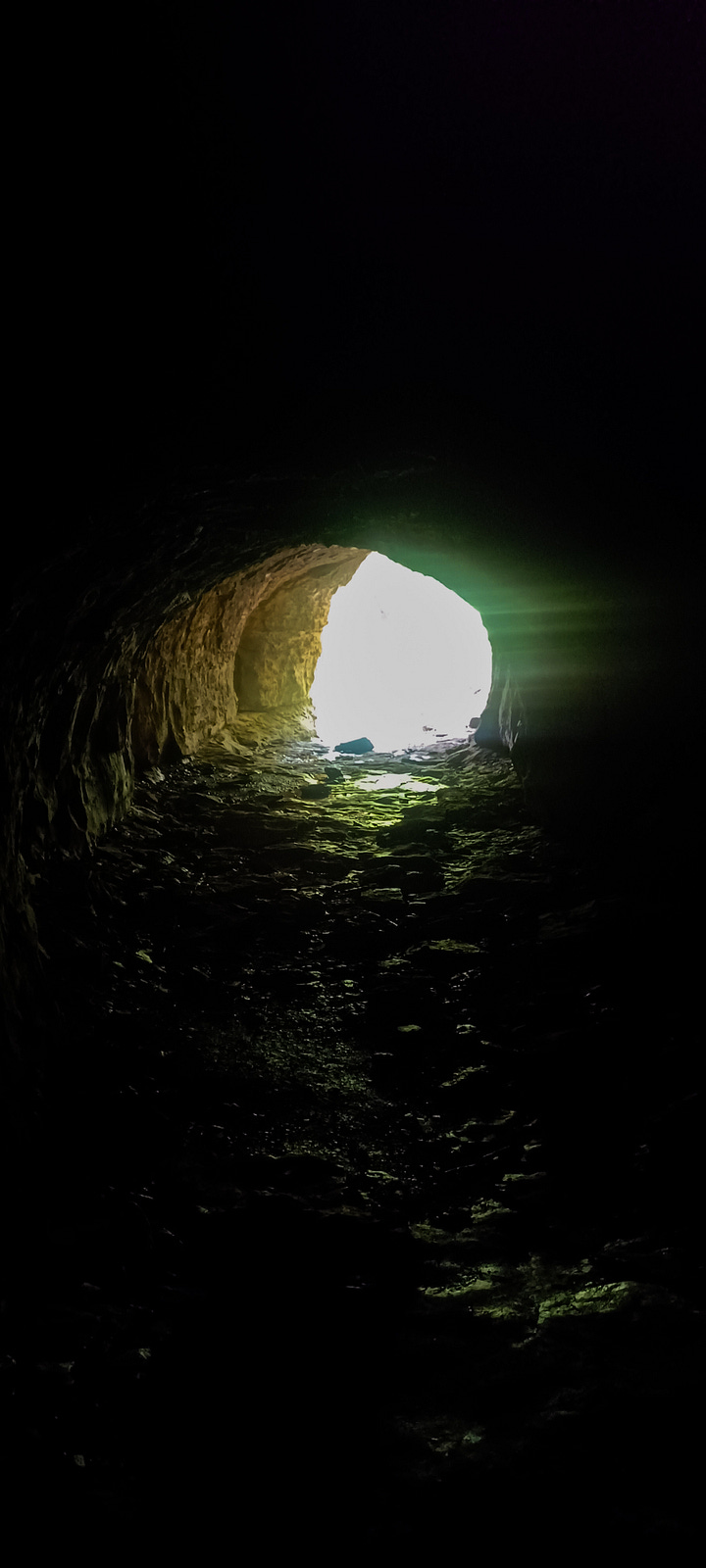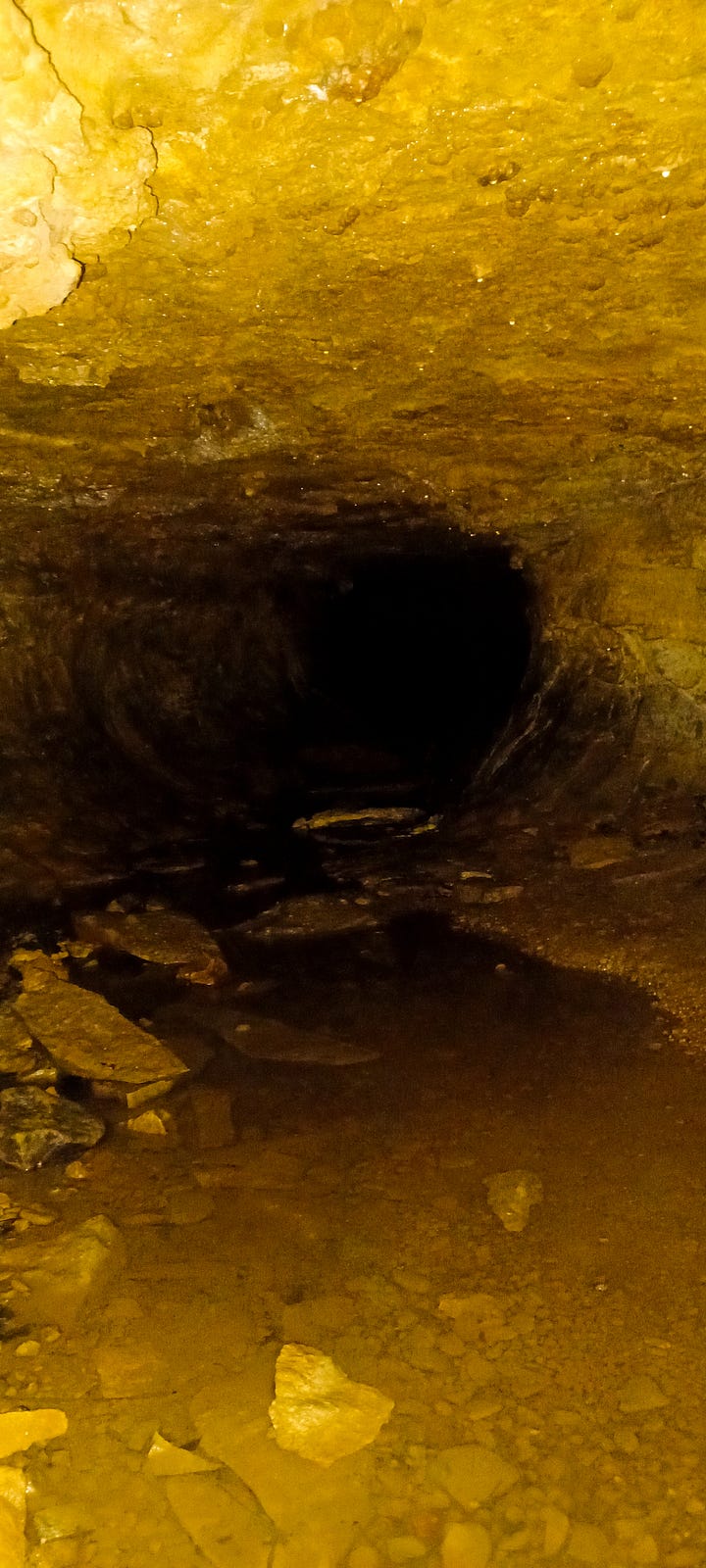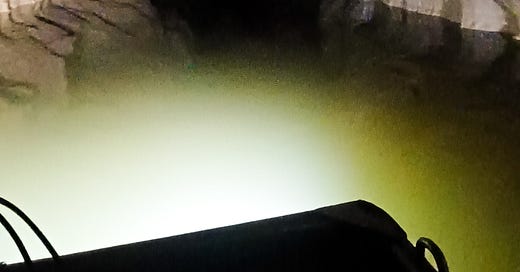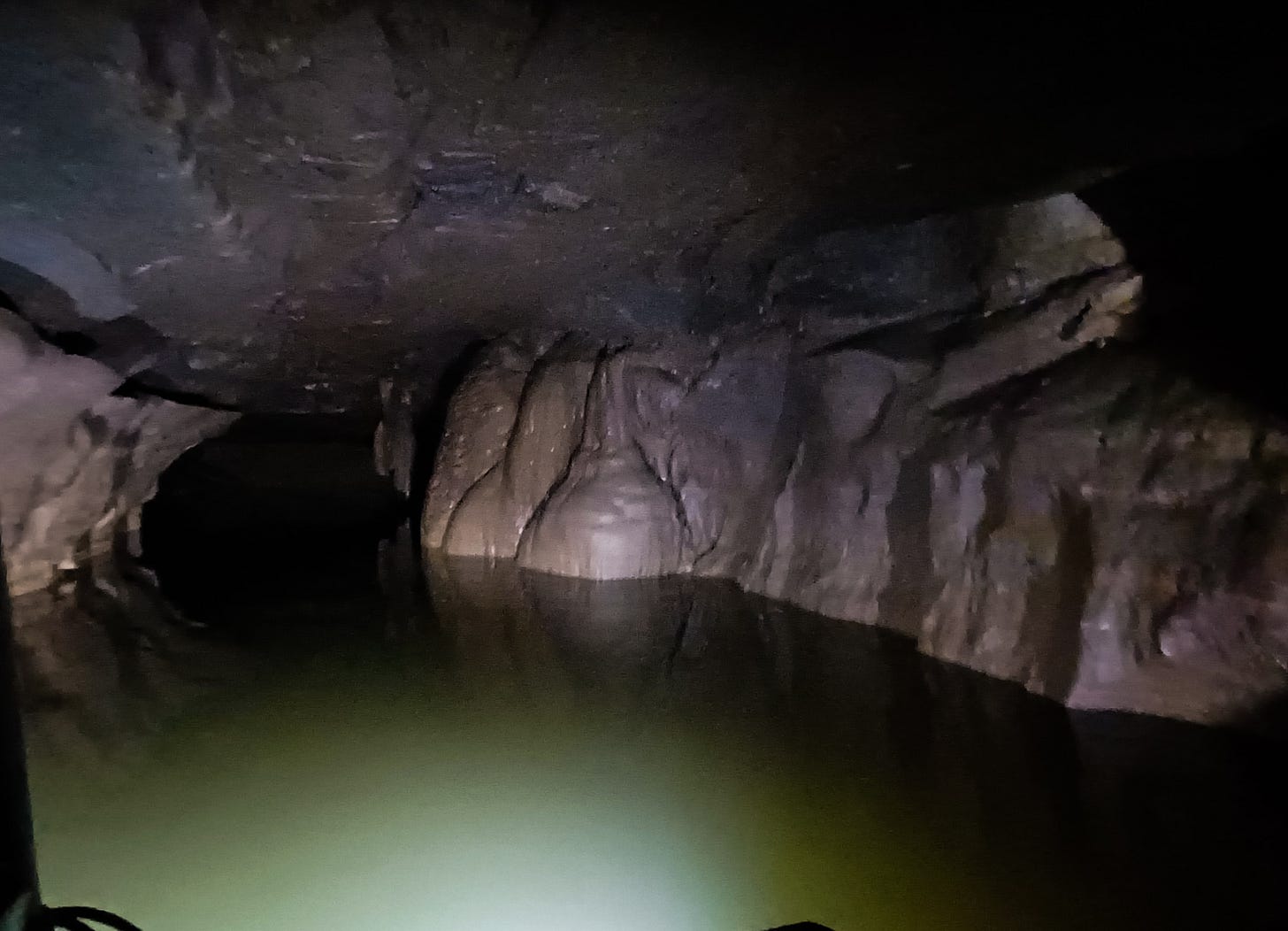The darkness of the cave is total. We are floating on the skin of the longest navigable underground river1 in North America in a little boat. Roughly seventy feet of limestone sits between our heads and the world the sun touches. “If you’re afraid of the dark, close your eyes,” Charon says. Everyone in the boat seems to hold their breath with me, listening to small drips of water dropping lightly into the starless river.
When he turns the lights on the boat back on, Charon tells us that that dark is darker than any night on earth - no moon, no stars, no firelight - nothing to illuminate your surroundings. Of course, his name isn’t actually Charon - but who else could it be ferrying passengers along a subterranean river for his living, which, by the logic of western mythology, could only be the river of the dead?
If you’ve been following along for a minute you already know that I recently moved to Indiana, where I’m setting about getting to know the land where I live now. I walk softly on the hiking trails calling Hello Hi Hey there, I’m new here, hello hello hello. One of the natural features that this area of the country is famous for is its wealth of limestone deposits right at the earth’s surface. Limestone is a bedrock formed from ancient, warm, shallow oceans - millions upon millions of years of sea creatures living, dying, and falling to the ocean floor to be preserved as this porous, eminently shape-able rock.
“And after the white clean beaches and shelf sands had spread their broad veneer, lime muds began to accumulate in the epicratonic seas. The lime muds were the skeletons, the macerated shells, the calcareous hard parts of marine creatures. The material turned into limestone,” is John McPhee’s account of it in Annals of the Former World, his wide-ranging tome about geology in North America that I’ve been picking my way through for the last seven years or so. This rock is very water soluble, allowing rain and runoff to carve multitudes of shapes in underground spaces.
“Limestone landscapes are rich with clandestine places,” as Rob Macfarlane says in his incredible book Underland: A Deep Time Journey (a book which I did not expect to be so practically helpful to me in Indiana). “They have the unexpected volumes of a lung’s interior. Portals give access to their extensive underland: pots and sinkholes, swallets where streams vanish into their own beds.” There are over four thousand (Four. Thousand.) known caves in Indiana alone. Imagine how many are unknown.
The entrance to the underground river on which I floated in the dark with a small group of strangers was the earth’s secret until 1941 - it had been hidden till then by a three-foot thick slab of limestone at the bottom of a farmer’s pond (as Charon tells it). One day that thin limestone bottom broke and all of the pond water disappeared suddenly, carried away by the underground river. In the 60s and 70s cavers were allowed to start exploring and mapping the cave’s features. They are still mapping it: more than twenty miles of river sluicing through cave and counting. Blind cave salamanders are one of the several inhabitants; skin grows over their vestigial eyes and they find food by feeling the electric pulses of living things through the water via sensors in their faces (a friendly reminder that every living thing is a tiny lightning storm).

When I look into the maw of a cave, as I did a few times in preparation for writing this newsletter, I feel a violent mix of feelings that can perhaps best be summed up in the phrase “The Call of the Void.”
I learned this phrase from my friend Skye, just after I’d driven us across the Sam Hill Memorial Bridge which takes you across the Columbia River Gorge if you’re heading back to Portland from the Wallowa Mountains in western Oregon. The gorge is famous for its extremely high winds, and I had expressed surprised awe at how tightly I needed to hold onto the steering wheel with both hands to keep the car on its path across the bridge. Once we’d made it to the other side Skye told me she’d felt the Call of the Void and was possessed by an intense urge to karate-chop my arms so that I let go of the wheel. You have probably felt this feeling at some point - a fleeting intrusive thought, immediately suppressed. I am not a mental health expert but it does not seem related to depression or even suicidal ideation - it’s just sometimes the case that it might occur to one to drive their car off a bridge for a moment as they are on said bridge (for example), even if they would never actually do it.
“’A peak can exercise the same irresistible power of attraction as an abyss,’ wrote Theophile Gautier in 1868, and the reverse is also true.” Caves have perhaps always been a contradictory space for humans and the hominids who came before us - a mixture of fear and apprehension perhaps only bested by the desire to know what is inside. Time in deep darkness changes us, we feel a tug of longing for the transformation that an underworld journey promises, “by the associated visionary powers of darkness and blindness,” as Macfarlane says. Portals is the word for the archetypal sway a cave holds over us.
In Celtic myth and folktale, any passage underground can be a portal to the underworld. James Mackillop2 articulates a more localized idea of many underworlds in the ancient Celtic imagination, each with their own entrance - whether a cave or a rocky outcrop rising out of the sea. And as we know, an underworld journey is both mythic and something that we may feel we’ve been through on a metaphorical level in our lives. But bodies take metaphors seriously, as Pierre Bourdieu reminds us,3 which lends a literal cave journey a certain kind of intensity.
“[T]he physical context of the caves - their tunnels, passages and corridors to be negotiated and thresholds to be crossed - provided a metaphor for the journey of the rite of passage. The sensory experiences of the individual moving through the caves during such a rite would have served to instill a feelings of irrevocably changed personhood, matching the change of status being socially marked by the rite. And, in this context, darkness - standing for invisibility, death and rebirth and experienced as disorienting, confusing, and frightening - would have contributed to this feeling of transformation,” Ruth D. Whitehouse writes in her contribution to The Archaeology of Darkness, a fascinating book about the relationships that ancient humans had to caves, particularly caves as prehistoric ritual spaces for initiation rites, or devotion to “cults of abnormal water,” as in the case of one Italian cave she describes at length.
A week ago I stood at the mouth of another, much smaller cave in a nearby forest preserve which I’d hiked in a ways to reach, filling alternately with trepidation and elation as I climbed the switchbacks up and down the miles to that destination in the muggy August heat. The cave mouth is set into a steep hill bank, which falls away into a ravine below.
There were four younger folks (At this point I genuinely have no idea how old people are by looking at them, these folks were probably somewhere in their twenties.) chatting loudly at the entrance about their sojourn into the depths of the cave. This was when I started to realize that I did not really know what I was in for with this particular cave - it turns out the AllTrails description neglected to mention its depth - it passes completely through the hilltop from one side to the other if one has the inclination to crawl and squeeze through.
“You have to crawl for a little while but if you just keep going there’ll be room to stand up again!” one of the cavers said.
“You have a back-up light, right?” another asked me seriously. Oh, of course! I lied through my teeth.
“Seriously whatever cave mites were in there are still biting me,” another muttered to himself, introducing a horror that had not previously occurred to me.
I left behind their friendly voices and walked into the cave. The first couple dozen feet of cave were illuminated by the sunny afternoon outside and it was easy to see the small bit of water running on the cave floor and ceiling, the ripples of tiny stalactites forming above like the inverse of that one Joy Division album cover, and some off-shoots into the cave’s ceiling and back wall that had been eroded into deep pockets. Then the cave took a sharp ninety degree turn to the right and into utter blackness. I turned on the flashlight on my phone and began to walk towards the void. Very quickly I needed to hunch over, and then crouch down soon after that. I kept looking behind me at the receding light pouring in from the entrance around that first corner and realizing how unprepared I was to venture into this specific underworld. When I came back out towards the entrance of the cave I had just had a taste and it made me very, very curious about what other kinds of underworlds I might find if I went looking.


Back in the boat on the starless river, before Charon turns the lights back on, in the too-short moments of complete darkness within the cave, I feel a rising panic as the physical reality of all of the many tons of rock above us comes crashing into my mind. That morning I had been re-reading Macfarlane’s account of wriggling, worm-like through a tiny passage carved out in the miles and miles of limestone quarries and caverns beyond the catacombs under Paris, feeling the vibrations of the metro directly above him and the terror he felt, despite not being claustrophobic and extensive experience with caving.4 If he can do that, then I can do this, I say to myself.
I wonder what it would be like to stay there much longer in the total darkness and silence, listening just to the water dripping from the ceiling. What would happen if we stayed in the dark for five minutes, or twenty, or an hour? How would we be changed by that time in the inky black of eternal night? When would our eyes become vestigial like the cave salamanders, receiving instead the “associated visionary powers”?
I take it the fear in and I put it somewhere else for the time being, in service of the journey - on whatever miniscule level this venture can call itself a kind of initiation rite. When we emerge from the cave over an hour after we entered it, the sun-drenched summer world feels like a bad joke, or a circus attraction gone off the rails. “Bye, bye, Miss American pie” plays on the speakers by the picnic area. Plants slurp their nutrients from the land below and the sky above. The gift shop offers sacks of sand with mass-produced arrowheads hidden inside for the (guaranteed!) finding under fluorescent lights, a sure thing. We have gone down into one of the strangest and most disorienting places I’ve ever been in my life, one which stretches the imagination with its physical reality of water, stone, and darkness, and emerged to find the regular world of light and humans and commerce has been bent into something that for a moment feels nearly as strange and disorienting - and I think this is the gift of the starless river in the cave.
This small initiation rite is perhaps a physical way to acknowledge the secrets and the complexity of the land where I’ve come to live; a spell for binding, a spell for respect. No matter how much I explore and map the aboveground terrain, may I never forget that the earth is keeping an uncountable multitude of secrets underneath my feet.
Hey, thanks for reading! See ya next time.
Blue Spring Caverns in Bedford, Indiana
In his book Myths and Legends of the Celts
From Outline of a theory of practice - but which I found in Archaeology of Darkness, edited by Marion Dowd and Robert Hensey from Oxbow Books.
This chapter alone is worth the price of the book as far as I’m concerned, and I have continued to think regularly about it since I first read Underland a few years ago. Here’s a snippet:
“After the war, the cult of the catacombs began to grow. Increasing numbers of people were drawn down into them for purposes of concealment, crime or pleasure. These users of the network became known as ‘cataphiles’ - ‘lovers of the below.’ In 1955 access to the catacomb network was made illegal, outwith a small area of show ossuaries that were kept open for purposes of tourism. Attempts to police the space were formalized: specialist police - quickly nicknamed ‘cataflics’ and ‘catacops’ - were trained in the network’s geography. Barrier walls were built across main subterranean routes, and the entrances to the network (tunnels, gates, manholes) were welded and locked shut. But the cataphiles kept coming. For the labyrinth offered a space where Paris’s subcultures could go to grow. It became - and still is - what anarchist-theorist Hakim Bey calls a ‘Temporary Autonomous Zone’: a place where people might slip into different identities, assume new ways of being and relating, become fluid and wild in ways that are constrained on the surface.” (page 142-143)







Uggghhh this is so so good!! I just dipped back into Underland for the who-knows-how-manyth time, so the timing is just 🤌. Also, “a friendly reminder that every living thing is a tiny lightning storm?” Sending you gratitude and love for these gorgeous reflections. Your writing is a delight.
WOW, you and I are in very similar research boats (pun intended) at the moment!! I've been researching the vast karst limestone cave system underneath central Texas for a few years now. So glad I found your newsletter through Landscapes, and if you ever wanna talk caves and limestone consider me interested. Loved this piece, cheers!